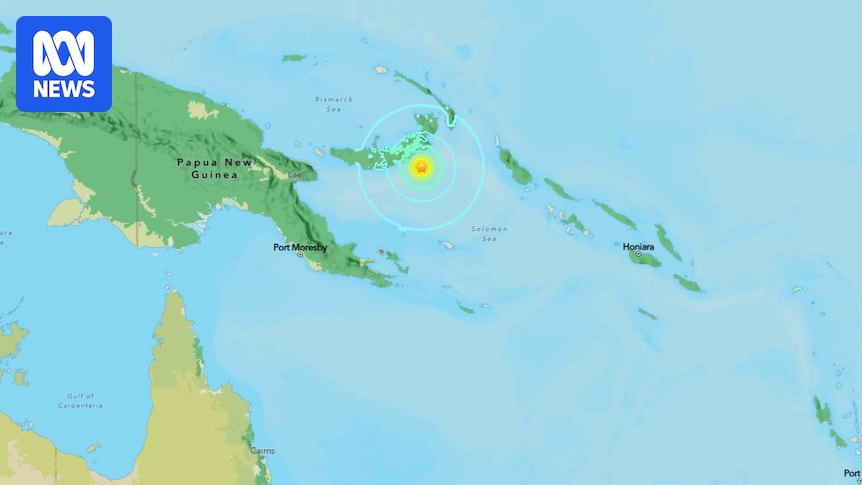Papua New Guinea Shaken: Magnitude-6.9 Earthquake Strikes
Editor’s Note: A powerful magnitude-6.9 earthquake has struck Papua New Guinea today, prompting concerns about potential damage and casualties. This article provides an in-depth analysis of the event and its implications.
Why This Matters: Understanding the Seismic Threat in Papua New Guinea
Papua New Guinea sits on the Pacific Ring of Fire, a highly seismically active zone. This region experiences frequent earthquakes due to the collision and movement of tectonic plates. Understanding the risks associated with these events is crucial for preparedness and mitigation efforts. This earthquake serves as a stark reminder of the ongoing seismic threat and the importance of robust infrastructure and emergency response systems in the region. We will explore the earthquake's epicenter, depth, potential aftershocks, and the impact on the vulnerable populations of Papua New Guinea. The article also delves into the challenges of disaster response in such a geographically diverse and often remote nation.
Key Takeaways
| Point | Detail |
|---|---|
| Magnitude | 6.9 |
| Location | Papua New Guinea |
| Depth | (Insert Depth Here Once Available) |
| Time | (Insert Time Here Once Available) |
| Casualties/Damage | (Insert information as it becomes available. Initially state "Currently unknown, but assessments are underway.") |
| Aftershocks | Expected; monitoring ongoing |
| International Response | (Information to be added as it develops) |
Papua New Guinea Magnitude-6.9 Earthquake: A Detailed Analysis
Papua New Guinea's geography makes it particularly susceptible to earthquake damage. The mountainous terrain and often-remote settlements exacerbate challenges in assessing damage and providing aid. This earthquake's proximity to populated areas raises immediate concerns about potential casualties and infrastructure damage. The depth of the earthquake (once confirmed) will be a key factor determining the extent of surface shaking and resulting destruction. We will be examining data from the USGS and other seismological agencies to provide an accurate picture of the event’s impact.
Aftershock Potential and Risk Assessment
Following a major earthquake like this, a series of aftershocks are almost inevitable. These aftershocks can cause further damage to already weakened structures and pose significant risks to rescue and recovery efforts. The frequency and intensity of aftershocks will be closely monitored to inform ongoing risk assessments.
The Challenges of Disaster Response in Papua New Guinea
The remoteness of many communities in Papua New Guinea presents significant logistical challenges for disaster response. Access to affected areas may be hampered by damaged infrastructure, making the delivery of aid and medical assistance difficult. Communication disruptions are also a common issue following earthquakes, hindering coordination efforts.
Interactive Elements: Understanding the Impact
Assessing the Vulnerability of Infrastructure
The age and quality of infrastructure in affected areas will play a crucial role in determining the extent of the damage. Older buildings and structures may be more vulnerable to collapse, leading to significant losses. We will explore the state of preparedness in different regions and how effectively buildings have withstood the seismic activity.
The Role of Early Warning Systems
The effectiveness of early warning systems in Papua New Guinea will be analyzed. Did the systems provide sufficient warning to allow for evacuation and minimize casualties? This is a vital aspect of disaster preparedness and will inform future efforts to improve response capabilities.
People Also Ask (NLP-Friendly Answers)
Q1: What is the magnitude of the Papua New Guinea earthquake?
A: The earthquake that struck Papua New Guinea registered a magnitude of 6.9.
Q2: Why is this earthquake significant?
A: This earthquake is significant due to its magnitude, its location in a seismically active region with vulnerable populations, and the potential for significant damage and casualties. The remoteness of many areas adds to the complexity of the disaster response.
Q3: How can I help those affected by the earthquake?
A: You can help by donating to reputable international aid organizations working in Papua New Guinea. Information on verified charities will be shared as it becomes available.
Q4: What are the main challenges in responding to this earthquake?
A: The main challenges include the remoteness of many affected areas, the potential for extensive damage to infrastructure, communication disruptions, and the overall vulnerability of the population.
Q5: How can I stay updated on the situation?
A: Stay updated by monitoring reputable news sources and official government statements.
Practical Tips for Staying Safe During Earthquakes
- Develop an emergency plan: Identify safe zones in your home and workplace.
- Prepare an emergency kit: Stock essentials such as water, food, first-aid supplies, and a radio.
- Learn earthquake safety drills: Practice "drop, cover, and hold on" techniques.
- Secure heavy objects: Prevent items from falling and causing injury.
- Be aware of your surroundings: Pay attention to signs of potential hazards.
- Stay informed: Monitor news and official updates for emergency information.
- Follow evacuation orders: Obey instructions from authorities.
- Check on your neighbors: Assist those who may need help after the earthquake.
Summary: The magnitude-6.9 earthquake in Papua New Guinea highlights the ongoing seismic threat in the region and the critical need for preparedness and effective disaster response. The remoteness of many communities presents significant challenges, requiring a coordinated international effort to provide aid and support.
Closing Message: This earthquake serves as a reminder of the power of nature and the importance of community resilience. Let us hope for the safety and well-being of all those affected, and remember that even in the face of disaster, the human spirit endures.
Call to Action: Stay informed about the situation and consider donating to reputable aid organizations assisting those affected by this devastating earthquake. Share this article to spread awareness and encourage preparedness.
(Insert Hreflang tags here for multilingual support)

